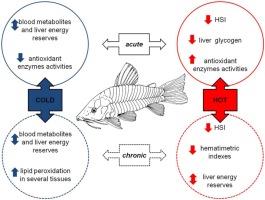Effect of thermal stress on metabolic and oxidative stress biomarkers of Hoplosternum littorale (Teleostei,Callichthyidae) |
| |
| Affiliation: | 1. Adaptive Biology Laboratory, Department of Cell Biology, Federal University of Parana, Curitiba, Paraná, Brazil;2. Basic Bioscience Institute, Taubaté University, Taubaté, São Paulo, Brazil;3. Department of Biology, Federal University of Sao Carlos, Sorocaba, Sao Paulo, Brazil;4. Department of Biochemistry, Federal University of Paraná, Curitiba, Paraná, Brazil;1. Department of Aquatic Biosciences, Chiayi University, Chiayi 600, Taiwan;2. Graduate Institute of Biomedical and Biopharmaceutical Sciences, National Chiayi University, Chiayi 600, Taiwan |
| |
| Abstract: | 
The present study aimed to investigate in Hoplosternum littorale (Hancock, 1828) the effects of different water temperatures (10 °C, 25 °C-control group- and 33 °C) on physiologic and metabolic traits following acute (1 day) and chronic (21 days) exposures. We analyzed several biomarker responses in order to achieve a comprehensive survey of fish physiology and metabolism under the effect of this natural stressor. We measured morphological indices, biochemical and hematological parameters as well as oxidative stress markers. To evaluate energy consumption, muscle and hepatic total lipid, protein and glycogen concentrations were also quantified. Extreme temperatures exposures clearly resulted in metabolic adjustments, being liver energy reserves and plasma metabolites the most sensitive parameters detecting those changes. We observed reduced hepatosomatic index after acute and chronic exposure to 33 °C while glycogen levels decreased at both temperatures and time of exposure tested. Additionally, acute and chronic exposures to 10 °C increased liver lipid content and plasma triglycerides. Total protein concentration was higher in liver and lower in plasma after chronic exposures to 10 °C and 33 °C. Acute exposition at both temperatures caused significant changes in antioxidant enzymes tested in the different tissues without oxidative damage to lipids. Antioxidant defenses in fish failed to protect them when they were exposed for 21 days to 10 °C, promoting higher lipid peroxidation in liver, kidney and gills. According to multivariate analysis, oxidative stress and metabolic biomarkers clearly differentiated fish exposed chronically to 10 °C. Taken together, these results demonstrated that cold exposure was more stressful for H. littorale than heat stress. However, this species could cope with variations in temperature, allowing physiological processes and biochemical reactions to proceed efficiently at different temperatures and times of exposure. Our study showed the ability of H. littorale to resist a wide range of environmental temperatures and contributes for the understanding of how this species is adapted to environments with highly variable physicochemical conditions. |
| |
| Keywords: | Fish Temperature Physiological adjustments Energy reserves Lipid peroxidation |
| 本文献已被 ScienceDirect 等数据库收录! |
|

